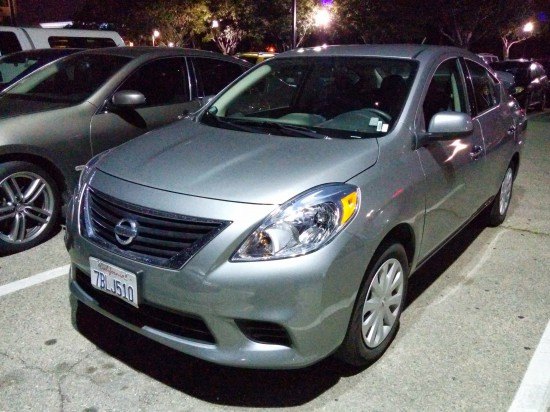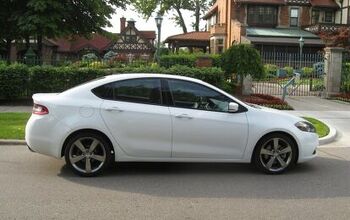Rental Car Review: A Tale of Two Econoboxes

Last month, I took two business trips where I had to rent a car: one to Boston and one to Los Angeles. I rolled the Hertz dice and ended up with a Chrysler 200 in Boston and a Nissan Versa SV at LAX. Each was a 24-hour rental, but the prices were remarkably different. The Chrysler: $61.59 for one day. The Nissan? $116.31 for one day. If the street price to buy one of these cars was anything in relation to the difference in rental price, everybody would be buying the Chrysler. Boston Strong!
Both cars were as un-optioned as they’re made. Bluetooth? Nope. The Nissan curiously had a third-party Bluetooth system hacked into the car, but it didn’t work. The Nissan also had a bunch of things glued to the windshield, which I presume include a GPS tracking feature as well as an annoying multicolored LED that faces out and blinks random colors as you’re driving down the street. Most likely, this Versa served in an earlier life as part of some ZipCar-esque car sharing service.
Anyway, before we get into the driving impressions, a Chrysler 200 base model seems to cost $21,540 ($495 more if you want Bluetooth). The Versa SV is $15,240 ($760 more if you want Bluetooth, navigation, and other electronic gadgets). The Chrysler has a 2.4 liter engine versus the Versa’s 1.5 liter. The Chrysler has a 4-speed auto, versus the Nissan’s CVT; pricier Chrysler 200’s have a 6-speed auto, but not this one. Overall performance was probably about the same, but neither car inspires you to push it. I will give credit to the Chrysler for being a noticeable step up with interior quality (e.g., having a leather-wrapped steering wheel). Road noise was reasonably muffled, and the car felt generally solid over bumps and other road indignities. The Nissan was just a cheap, unapologetic econobox.
Before I go on, I must digress. I drove through Cambridge and Boston, on my way out to the ‘burbs and back again to Logan Airport. I even drove right past Fenway Park, a side effect of an epic digression to pick up a pack of America’s only domestically brewed Trappist beer. (Highly recommended!) Not once, not a single time, did somebody honk at me. Nobody cut me off. When I signaled, people let me in. Boston, what’s wrong with you? Where are your passive aggressive moronic idiot nutjob drivers? Have you gone soft on me? (Do Boston drivers feel sorry for you if you’re driving a Chrysler 200?!)
Anyway, back to the cars. The Chrysler is rated for 20 city / 31 highway mpg. I figured out the reset button once I got on the highway, so I managed to get 32 mpg (indicated) on the remarkably traffic-free Saturday morning drive. Once I got caught up in Boston traffic, using Google’s truly impressive routing skills to follow one obscure side street into the next whilst cutting from Quincy to Braintree (kids: don’t try this at home), my indicated mileage dropped, bringing me in at 22 mpg combined. Still, not a bad performance. The Nissan, though, was stunning in the mileage department. LA traffic being what it is, there’s no such thing as freeway driving. It’s all about “combined” driving, and my final tally was 33.8 mpg (indicated), splitting the difference between the 31 city / 40 highway rating. (Overall, I’d say that I put both cars through similar drives, so the mileage difference here is representative of what happens with bigger engines in heavier cars: roughly 1000 pounds different.)
But CVTs! They bore us! There is much mileage to be gained when you can run the engine at arbitrarily chosen speeds. Want to go fast? High RPM. Want to save gas? Low RPM. This is great if you care about efficiency, but it’s a nightmare if you’re used to using engine noise as a proxy for looking at the speedometer. If you put your foot down just a little bit, the car might well be accelerating, but the engine noise is holding constant. You just never know, so your best bet is to set the cruise control and forget trying to enjoy your drive. The Nissan, trying to squeeze all the juice out of its tiny engine, does precisely this. The engine’s noise, and the tachometer’s readout, are nothing other than a direct measure of where your foot happens to be on the gas. Consequently, the Versa is as boring as a lecture about how CVT transmissions can optimize engine power output and improve mileage, but at least it’s honest. What about the Chrysler? Despite having a bit of traditional engine rev and gear changing, it’s every bit as dull. You can option up for a big V6 but then you’re competing in a whole other segment.
Recommendations: if you’re trying to get a cheap car, get the cheaper Nissan Versa with the 6-speed manual. You can at least pretend you’re not driving a cheap econobox, and you won’t care that you’re getting 10% worse gas mileage. On the other hand, the base-model Chrysler 200, for the extra few bucks, and with discounts maybe not that many extra, gives you something resembling a luxury car experience. Sure, the drivetrain is nothing more than a high-achieving econobox, but the rest of the car is a step up. The quiet ride, all by itself, would make the Chrysler 200 a much better car if you spent a lot of time doing your daily soul sucking commute. When the 2nd-generation Fiat-enhanced version comes out next year, with a base price of $21,700, I expect it to be a very competitive car. Not only will it have more gear ratios (9 speeds!) and better mileage (36 mpg freeway!), but it will also be decidedly not ugly. It might even have some excitement. Maybe.

More by Dan Wallach
Latest Car Reviews
Read moreLatest Product Reviews
Read moreRecent Comments
- MaintenanceCosts If you want a car in this category, you want interior space, comfort, predictability, and low running costs.That probably favors the RAV4 Hybrid, with second place going to the CR-V hybrid. The CR-V is a nicer-looking and nicer-feeling product, but it just has not proved quite as low-drama as the Toyota.The RAV4 Prime is a compelling car but it's extremely expensive and still hard to get, and the regular hybrids are a better value.There's no reason to choose the non-hybrid of either one. You get higher running costs and less refinement for no benefit.
- Aaron Id lean towards the rav4. The crv1.5 turbo has had issues. The rav 4 has both port and direct injection, no cvt. Also the Toyota hybrid systems have been super stout
- Jeff My wife owned a 2013 AWD CRV since new it has been trouble free but I am not a fan of turbos so I would lean toward the Rav 4. If I were getting a hybrid it definitely would be a Rav 4 with Toyota's hybrid system being the best. Honestly you could not go wrong with either a CRV or a Rav 4. My third choice would be a Mazda.
- 3-On-The-Tree We like our 2021 Rav4 non hybrid.
- Vatchy FSD never has been so what is with the hype about robo-taxis? You would need the first in order for the second to work.








































Comments
Join the conversation
"CVTs! They bore us! There is much mileage to be gained when you can run the engine at arbitrarily chosen speeds. Want to go fast? High RPM. Want to save gas? Low RPM. This is great if you care about efficiency, but it’s a nightmare if you’re used to using engine noise as a proxy for looking at the speedometer." Easy fix. Get a manual. Nearly impossible to find on a rental lot, hell, on any lot, but so worth it.
"You can at least pretend you’re not driving a cheap econobox, and you won’t care that you’re getting 10% worse gas mileage." The manual won't actually get worse gas mileage unless the driver is so incompetent that he shifts as poorly as the EPA test requires for manuals.